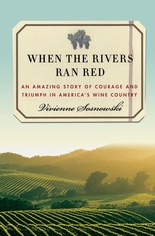A story of Prohibition in wine country – When the Rivers Ran Red now in paperback

One of the ways to really appreciate winemakers’ “passion” for wine is to gain some historical perspective, such as how Napa Valley vintners survived during the 13 years of Prohibition between 1920 and 1933. The best-selling book When the Rivers Ran Red written by Vivienne Sosnowski chronicles this period through individual experiences, adding color to a period that most of us see as black and white. The book is now in paperback ($16) and makes a great addition to the wine or history lover’s library.
The story describes in the years leading up to Prohibition how grapegrowing and winemaking were a cultural part of life for the many European immigrants in the North Coast wine regions. “Local churches celebrated the annual harvest with song and prayer and displays of bounty of the land….” While the temperance movement existed from the founding of the country, the threat of Prohibition promulgated by politicians and special interests on the East Coast seemed far removed from vintners living in the remote Northern California countryside before TV and internet. Louis Foppiano is quoted to say “Back then, no one ever thought it would happen.” After all, the target of everyone’s ire were the saloons and the social ills created by excess whiskey and beer consumption.
Even back then, 330,000 acres of California’s agricultural land were planted to grapes in 39 of its 58 counties, making grapevines an important economic crop. Yet the Volstead Act legislation passed as President Wilson’s veto was overridden by a hastily called House vote on a day when a large number of “Wets” were absent from session. According to the New York Times, if House members from the two most anti-Prohibition delegations – New York and Pennsylvania – were present for the vote, Prohibition would never have passed.
Prohibition was by no means completely dry. The Act permitted certain wineries to make wine for medicinal and religious purposes, and allowed individuals to make wine at home up to 200 gallons (1,000 bottles) per household per year. It was the latter exception that created a huge demand for fresh wine grapes by immigrant populations in the Midwest and East Coast. Napa and Sonoma wine grape prices jumped from $15/ton pre-Prohibition to $60-70/ton for a time, creating a “financial supernova” for grapegrowers.
But these benefits did not accrue to all the vintners, particularly the smaller players. Many converted their vineyards to other cash crops while others bootlegged to save their land, a “cruel blow” to the self-respect of the proud and hard-working immigrants who “wanted dearly to obey the laws of their adoptive home” and who had, prior to Prohibition, been engaging in honorable work.
Sosnowski describes through extensive research and interviews the ways that vintners survived during this time, facilitated by a largely “see no evil” attitude and by sympathetic or otherwise corrupt enforcement officials. But after several years of worsening crime driven by illicit profits, and due to the astronomical cost of enforcement by an inept and corrupt enforcement body, national sentiment grew for reversal of Prohibition. This wave of sentiment surged as the Depression took hold and the loss of jobs and tax revenues engendered by Prohibition became impossible to defend.
Prohibition officially ended on December 5, 1933. The Sonoma Index Tribune called Prohibition “…one of the worst and most cruel experiences to which a thrifty and prosperous rural community was ever subjected at the hands of its own neighbors and country-men and all in the name of reform and smug morality.”
The repeal celebration took place in the tasting room of Inglenook winery, now Rubicon Estate. So next time you are in the Napa Valley, consider stopping by the restored Chateau and giving your own toast to the pursuit of wine and to the end of this infamous chapter in our history.
Sosnowski, Vivienne. When the Rivers Ran Red. New York: Palgrave Macmillan, in paperback September 2010.
